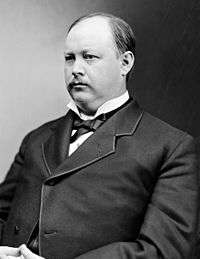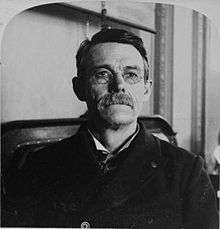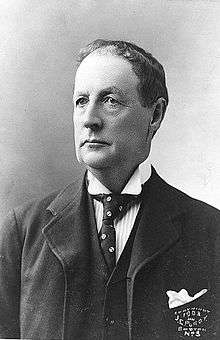United States House of Representatives elections, 1892
| | |||||||||||||||||||||||||||||||||||||||||||||||||||||||||||||||
| |||||||||||||||||||||||||||||||||||||||||||||||||||||||||||||||
| |||||||||||||||||||||||||||||||||||||||||||||||||||||||||||||||
| |||||||||||||||||||||||||||||||||||||||||||||||||||||||||||||||
Elections to the United States House of Representatives were held in 1892 for members of the 53rd Congress, taking place at the same time as the election of Grover Cleveland as President for the second, non-continuous, time, defeating incumbent Benjamin Harrison.
In spite of the presidential results, Harrison's Republican Party gained back some of the seats that had been lost in 1890 to the Democratic Party, but was still deep in the minority. The Republican pickups were a result of a number of Republican-friendly Northern districts reverting to form after voting Democratic in the previous election cycle. The third party Populists, who had high support among farmers and laborers in the South and West, also gained two seats.
Election summaries
This was the first election after reapportionment following the 1890 Census. Twenty-four new seats were added,[2] with 13 States gaining one seat each, two States gaining 2 seats each, and one state gaining 3 seats, and the remaining 28 states having no change. Several states did not redistrict following the apportionment of extra seats, and elected those new seats at-large.
| 218 | 2 | 11 | 1 | 124 |
| Democratic | ID | P | S | Republican |
| State | Type | Total seats |
Democratic | Republican | Populist | ||||
|---|---|---|---|---|---|---|---|---|---|
| Seats | Change | Seats | Change | Seats | Change | Seats | Change | ||
| Alabama | District | 9 | |
9 | |
0 | |
0 | |
| Arkansas | District | 6 | |
6 | |
0 | |
0 | |
| California | District | 7 | |
4 | |
2 | |
1 | |
| Colorado | District[Note 4] | 2 | |
0 | |
0 | |
2 | |
| Connecticut | District | 4 | |
3 | |
1 | |
0 | |
| Delaware | At-large | 1 | |
1 | |
0 | |
0 | |
| Florida | District | 2 | |
2 | |
0 | |
0 | |
| Georgia | District | 11 | |
11 | |
0 | |
0 | |
| Idaho | At-large | 1 | |
0 | |
1 | |
0 | |
| Illinois | District +2 at-large[Note 5] |
22 | |
11 | |
11 | |
0 | |
| Indiana | District | 13 | |
11 | |
2 | |
0 | |
| Iowa | District | 11 | |
1 | |
10 | |
0 | |
| Kansas | District +at-large[Note 5] |
8 | |
1 | |
2 | |
5 | |
| Kentucky | District | 11 | |
10 | |
1 | |
0 | |
| Louisiana | District | 6 | |
6 | |
0 | |
0 | |
| Maine[Note 6] | District | 4 | |
0 | |
4 | |
0 | |
| Maryland | District | 6 | |
6 | |
0 | |
0 | |
| Massachusetts | District | 13 | |
3[Note 7] | |
10 | |
0 | |
| Michigan | District | 12 | |
5 | |
7 | |
0 | |
| Minnesota | District | 7 | |
2 | |
4 | |
1 | |
| Mississippi | District | 7 | |
7 | |
0 | |
0 | |
| Missouri | District | 15 | |
14 | |
1 | |
0 | |
| Montana | At-large | 1 | |
0 | |
1 | |
0 | |
| Nebraska | District | 6 | |
1 | |
3 | |
2 | |
| Nevada | At-large | 1[Note 8] | |
0 | |
0 | |
0 | |
| New Hampshire | District | 2 | |
0 | |
2 | |
0 | |
| New Jersey | District | 8 | |
6 | |
2 | |
0 | |
| New York | District | 34 | |
20 | |
14 | |
0 | |
| North Carolina | District | 9 | |
8 | |
1 | |
0 | |
| North Dakota | At-large | 1 | |
0 | |
1 | |
0 | |
| Ohio | District | 21 | |
11 | |
10 | |
0 | |
| Oregon[Note 6] | District[Note 4] | 2 | |
0 | |
2 | |
0 | |
| Pennsylvania | District +2 at-large[Note 5] |
30 | |
10[Note 7] | |
20 | |
0 | |
| Rhode Island | District | 2 | |
2 | |
0 | |
0 | |
| South Carolina | District | 7 | |
6 | |
1 | |
0 | |
| South Dakota | At-large | 2 | |
0 | |
2 | |
0 | |
| Tennessee | District | 10 | |
8 | |
2 | |
0 | |
| Texas | District | 13 | |
13 | |
0 | |
0 | |
| Vermont[Note 6] | District | 2 | |
0 | |
2 | |
0 | |
| Virginia | District | 10 | |
10 | |
0 | |
0 | |
| Washington | At-large | 2 | |
0 | |
2 | |
0 | |
| West Virginia | District | 4 | |
4 | |
0 | |
0 | |
| Wisconsin | District | 10 | |
6 | |
4 | |
0 | |
| Wyoming | At-large | 1 | |
1 | |
0 | |
0 | |
| Total | 356 | |
220[1][Note 3] 61.8% |
|
124[1] 34.83% |
|
11[1] 3.1% |
| |
The previous election of 1890 saw the election of eight Populists, but no other third party or independent members.
[[Image:53 us house membership.png|thumb|500px|
]] |
[[Image:53 us house changes.png|thumb|right|450px|
]] | |||||||||||||||||||||||||||
Early election dates
In 1892, three states, with 8 seats among them, held elections early:
Complete returns
- D: Democratic
- I: Independent
- Pop: Populist
- Pr: Prohibition
- R: Republican
California
One new seat was added in reapportionment. Democrats had a net gain of one seat (taken from a Republican), and Populists gained a seat in the new district.
| District | Incumbent | Party | First elected |
Result | Candidates |
|---|---|---|---|---|---|
| California 1 | Thomas J. Geary | Democratic | 1890 | Re-elected | Thomas J. Geary (D) 56.8% E. W. Davis (R) 38.6% C. C. Swafford (Pop) 4.6% |
| California 2 | Anthony Caminetti | Democratic | 1890 | Re-elected | Anthony Caminetti (D) 53.2% John F. Davis (R) 43.1% C. H. Dunn (Pr) 3.4% J. H. White (I) 0.3% |
| California 3 | Samuel G. Hilborn | Republican | 1890 | Re-elected | Samuel G. Hilborn (R) 43.2% Warren B. English (D) 43.1% J. L. Lyon (Pop) 11.5% L. B. Scranton (Pr) 2.2% |
| California 4 | John T. Cutting | Republican | 1890 | Retired Democratic gain |
James G. Maguire (D) 49.2% Charles O. Alexander (R) 43.4% Edgar P. Burman (Pop) 6.5% Henry Collins (Pr) 1% |
| California 5 | Eugene F. Loud | Republican | 1890 | Re-elected | Eugene F. Loud (R) 46.4% J. W. Ryland (D) 43.3% Jonas Morrison (Pop) 7.9% William Kelly (Pr) 2.4% |
| California 6 | None (District created) | New seat Populist gain |
Marion Cannon (Pop) 56.3% Hervey Lindley (R) 38.8% O. R. Dougherty (Pr) 4.9% | ||
| California 7 | William W. Bowers (Redistricted from the 6th district) |
Republican | 1890 | Re-elected | William W. Bowers (R) 41.6% Olin Wellborn (D) 39% Hiram Hamilton (Pop) 14.6% M. B. Harris (Pr) 4.8% |
Florida
| District | Incumbent | Party | First elected |
Result | Candidates |
|---|---|---|---|---|---|
| Florida 1 | Stephen R. Mallory | Democratic | 1890 | Re-elected | Stephen R. Mallory (D) 99.2% Others 0.8% |
| Florida 2 | Robert Bullock | Democratic | 1888 | Retired Democratic hold |
Charles Merian Cooper (D) 76.0% Austin S. Mann (Pop) 24.0% |
Ohio
| District | Incumbent | Party | First elected |
Result | Candidates[3] |
|---|---|---|---|---|---|
| Ohio 1 | Bellamy Storer | Republican | 1890 | Re-elected |
|
| Ohio 2 | John A. Caldwell | Republican | 1888 | Re-elected |
|
| Ohio 3 | George W. Houk | Democratic | 1890 | Re-elected |
|
| Ohio 4 | Martin K. Gantz | Democratic | 1890 | Lost re-nomination Democratic loss |
|
| Fernando C. Layton Redistricted from the 5th district |
Democratic | 1890 | Re-elected | ||
| Ohio 5 | Dennis D. Donovan Redistricted from the 6th district |
Democratic | 1890 | Re-elected |
|
| Ohio 6 | John M. Pattison Redistricted from the 11 district |
Democratic | 1890 | Lost re-election Republican gain |
|
| Ohio 7 | William E. Haynes | Democratic | 1890 | Retired Republican gain |
|
| Ohio 8 | None (District created) | New seat Republican gain |
| ||
| Ohio 9 | None (District created) | New seat Democratic gain |
| ||
| Ohio 10 | Robert E. Doan | Republican | 1890 | Lost renomination Republican loss |
|
| William H. Enochs Redistricted from the 12th district |
Republican | 1890 | Re-elected | ||
| James I. Dungan Redistricted from the 13th district |
Democratic | 1890 | Lost re-election Democratic loss | ||
| Ohio 11 | None (District created) | New seat Republican gain |
| ||
| Ohio 12 | Joseph H. Outhwaite Redistricted from the 9th district |
Democratic | 1890 | Re-elected |
|
| Ohio 13 | Darius D. Hare Redistricted from the 8th district |
Democratic | 1890 | Re-elected |
|
| Ohio 14 | James W. Owens | Democratic | 1890 | Retired Democratic loss |
|
| Michael D. Harter Redistricted from the 15th district |
Democratic | 1890 | Re-elected | ||
| Ohio 15 | None (District created) | New seat Republican gain |
| ||
| Ohio 16 | Lewis P. Ohliger | Democratic | 1892 (s) | Lost renomination Democratic loss |
|
| Albert J. Pearson | Democratic | 1890 | Re-elected | ||
| Ohio 17 | None (District created) | New seat Democratic gain |
| ||
| Ohio 18 | Joseph D. Taylor | Republican | 1890 | Retired Democratic gain |
|
| Ohio 19 | Ezra B. Taylor | Republican | 1880 (s) | Retired Republican hold |
|
| Ohio 20 | Vincent A. Taylor | Republican | 1890 | retired Republican Hold |
|
| Ohio 21 | Tom L. Johnson | Democratic | 1890 | Re-elected |
|
South Carolina
| District | Incumbent | Party | First elected |
Result | Candidates |
|---|---|---|---|---|---|
| South Carolina 1 | William H. Brawley | Democratic | 1890 | Re-elected | William H. Brawley (D) 99.8% Others 0.2% |
| South Carolina 2 | George D. Tillman | Democratic | 1878 | Lost primary Democratic hold |
W. Jasper Talbert (D) 99.6% Others 0.4% |
| South Carolina 3 | George Johnstone | Democratic | 1890 | Lost primary Democratic hold |
Asbury Latimer (D) 91.2% John R. Tolbert (R) 8.6% Others 0.2% |
| South Carolina 4 | George W. Shell | Democratic | 1890 | Re-elected | George W. Shell (D) 85.7% Joshua A. T. Ensor (R) 14.3% |
| South Carolina 5 | John J. Hemphill | Democratic | 1882 | Lost primary Democratic hold |
Thomas J. Strait (D) 80.7% E. Brooks Sligh (R) 19.3% |
| South Carolina 6 | Previous incumbent Eli T. Stackhouse (R) died June 14, 1892 | Democratic hold | John L. McLaurin[Note 9] (D) 84.6% E. J. Sawyer (R) 15.3% Others 0.1% | ||
| South Carolina 7 | William Elliott | Democratic | 1890 | Retired Republican gain |
George W. Murray (R) 50.0% E. W. Moise (D) 49.6% Others 0.4% |
See also
Notes
- ↑ Three states held early elections between June 6 and September 12.
- 1 2 Dubin (p. 303) records 214 Democrats, 2 Independent Democrats, 127 Republicans, 11 Populists, and 1 Silver at the opening of the 53rd Congress, before several contested elections overturned a few results..
- 1 2 Includes 2 Independent Democrats: Michael J. McEttrick elected to MA-10, and William McAleer elected to PA-03.
- 1 2 Changed from at-large district.
- 1 2 3 Additional seat or seats elected at-large due to failure of State to redistrict.
- 1 2 3 Elections held early.
- 1 2 Includes 1 Independent Democrat.
- ↑ Nevada elected Francis G. Newlands, a member of the Silver Party.
- ↑ Also elected in special election for 52nd Congress
References
Bibliography
- Dubin, Michael J. (March 1, 1998). United States Congressional Elections, 1788-1997: The Official Results of the Elections of the 1st Through 105th Congresses. McFarland and Company. ISBN 978-0786402830.
- Martis, Kenneth C. (January 1, 1989). The Historical Atlas of Political Parties in the United States Congress, 1789-1989. Macmillan Publishing Company. ISBN 978-0029201701.
- Moore, John L., ed. (1994). Congressional Quarterly's Guide to U.S. Elections (Third ed.). Congressional Quarterly Inc. ISBN 978-0871879967.
- "Party Divisions of the House of Representatives* 1789–Present". Office of the Historian, House of United States House of Representatives. Retrieved January 21, 2015.
External links
- Office of the Historian (Office of Art & Archives, Office of the Clerk, U.S. House of Representatives)



